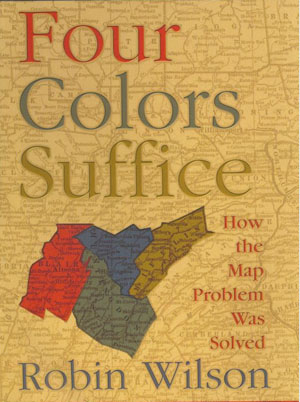
Four Colours Suffice
On October 23, 1852, Professor Augustus De Morgan wrote a letter to a colleague, unaware that he was launching one of the most famous mathematical conundrums in history--one that would confound thousands of puzzlers for more than a century. This is the amazing story of how the "map problem" was solved.
The problem posed in the letter came from a former student: What is the least possible number of colors needed to fill in any map (real or invented) so that neighboring counties are always colored differently? This deceptively simple question was of minimal interest to cartographers, who saw little need to limit how many colors they used. But the problem set off a frenzy among professional mathematicians and amateur problem solvers, among them Lewis Carroll, an astronomer, a botanist, an obsessive golfer, the Bishop of London, a man who set his watch only once a year, a California traffic cop, and a bridegroom who spent his honeymoon coloring maps. In their pursuit of the solution, mathematicians painted maps on doughnuts and horseshoes and played with patterned soccer balls and the great rhombicuboctahedron.
It would be more than one hundred years (and countless colored maps) later before the result was finally established. Even then, difficult questions remained, and the intricate solution--which involved no fewer than 1,200 hours of computer time--was greeted with as much dismay as enthusiasm.
Providing a clear and elegant explanation of the problem and the proof, Robin Wilson tells how a seemingly innocuous question baffled great minds and stimulated exciting mathematics with far-flung applications. This is the entertaining story of those who failed to prove, and those who ultimately did prove, that four colors do indeed suffice to color any map.
The four-color conjecture, formulated in 1852, was among the most popular unsolved problems in mathematics. Amateurs and professionals alike succumbed to its allure. It is, simply stated: four colors are all that is needed to fill in any map so that neighboring countries are always colored differently.
That the proof, which was completed in 1976, consumed a thousand pages and gobs of computer time hints at the hidden complexity encountered by those attempting to solve it. Recreational mathematicians will find Wilson's history of the conjecture an approachable mix of its technical and human aspects, in part because the math involved is understandable even to able middle-schoolers.
The conjecture seemed a snap to its originator, one Francis Guthrie, but his claimed proof has never surfaced; those proofs that did surface, prior to the final breakthrough by Kenneth Appel and Wolfgang Haken, contained fatal errors. Wilson explains all with exemplary clarity and an accent on the eccentricities of the characters, Lewis Carroll among them.